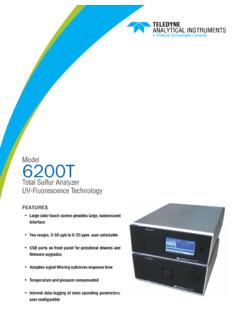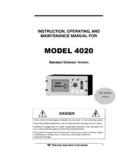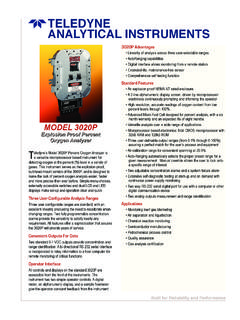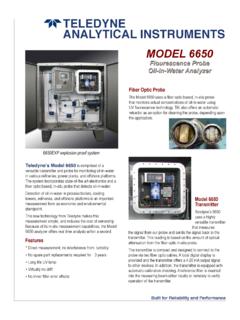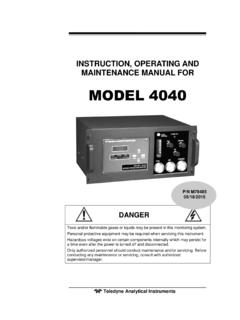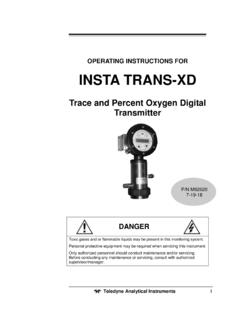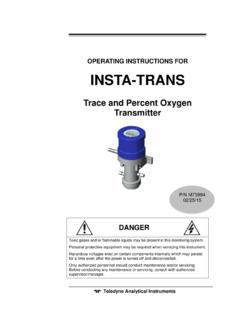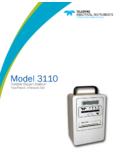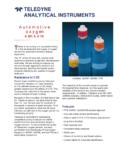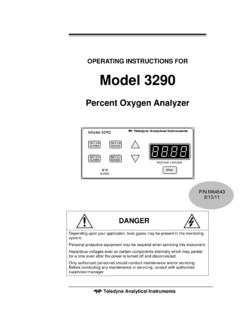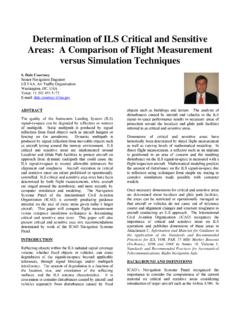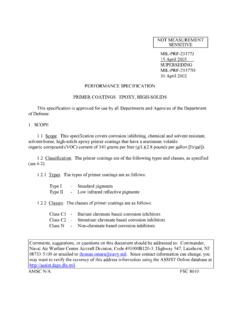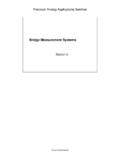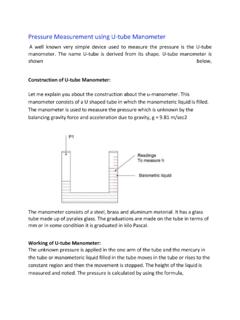Transcription of TELEDYNE ANALYTICAL INSTRUMENTS (TAI)
1 TELEDYNE ANALYTICAL INSTRUMENTS (TAI)Ron DownieSystems Engineering ManagerMay 4, 2005 Comparison of Hydrocarbon measurement TechnologiesTotal Hydrocarbon Analyzer in water (THC): Model 4080/4020 PPM Oil in Water UV Absorption Analyzer: 6600 PPM Oil in Water UV Fluorescence Analyzer: 6650 GENERAL DIFFERENCESANALYSISMODEL 4080 THC66006650 OIL ANALYSISFID (FLAME IONIZATION DETECTION)UV ABSORPTIONUV FLUORESCENCETECHNIQUELIQUID TO VAPOR STRIPPINGDIRECT FLOW THRU SENSINGDIRECT FLOW THRU SENSINGALL C+ IONS MEASURED FROM C-HAROMATIC FRACTIONS ABSORBAROMATIC FRACTIONS FLUORESCEDESIGNED TO MEASURE DISSOLVED HC SDESIGNED TO MEASURE EMULSIFIED OILSDESIGNED TO MEASURE EMULSIFIED OILSSAMPLINGPRESSURE/FLOW CONTROLEXTRACTIVEEXTRACTIVE OR IN-SITURANGE(S)5 PPM TO 1000 PPM3 PPM TO 200 PPM1 PPM TO 200 PPM(WITH DILUTION)
2 300 PPM TO 1000 PPM300 PPM TO 2000 PPM300 PPM TO 2000 PPMLIMITATIONSTSS < 10 PPM OR FILTERTSS < 10% RANGETSS < 1000 PPMOIL CONTENT<10 PPM WITHOUT DILUTIONSEE RANGESEE RANGE- MEASUREVOLATILE C-H BONDED CPD SCPD S THAT ABSORB UV IN WATERCPD S THAT UV FLUORESCE IN WATER* TEMP/SAMPLENON-FREEZING TO < 50 OC USUALLYNON-FREEZING TO 120 OCNON-FREEZING TO 120 OC, BUT MORECOOLING PERFORMED-TEMP SENSITIVE, REQUIRES POSSIBLE CONTROL* SAMPLEMUST BE SINGLE PHASECONC S > 20 PPM RECOMMEND HOMOGENIZERCONC S > 20 PPM RECOMMEND HOMOGENIZERIF NOT EMULSIFIED AT HIGHER CONC SCALIBRATIONMAKEUP HC OF CHOICE IN WATERSPECIFIC OIL OF INTERESTSPECIFIC OIL OF INTERESTALL HC S READ AS EQUIVALENTSALL OIL READ AS OIL OF INTERESTALL OIL READ AS OIL OF INTERESTPHYSICAL COND SPRESSURE > 10 PSIG, OR PUMPGRAVITY FLOW TO 10 PSIG OR PUMPGRAVITY FLOW TO 10 PSIG OR PUMPIF NO HOMOGENIZER USEDIF NO HOMOGENIZER USEDMAINTENANCEFILTER CHANGE, SUPPORT GASESSOURCE LIFE 1 YEAR +SOURCE LIFE 3 YR, CLEANING SHSCALIBRATION.
3 PREVENT HI TSSCLEANING SHS IF OIL SLUGS/RE-CALIBRATION CLEANING SHS IF OIL SLUGS/RE-CALIBRATIONTAI MODEL 4080 TOTAL HYDROCARBON ANALYSIS SYSTEMMore in depth information:4080 FEATURES: Measures Carbon Hydrogen bonded hydrocarbons in water, 0-2 ppm THC and up to typically 0-1000ppm Microprocessor based electronics (4020 new)* High sensitivity FID detection technologyWhen N2 is used to strip (remove) Hydrocarbons from water, the efficiency of doing this isrelated to the following:1)The polarity of the HC s, is related to their solubility in water (a polar solvent). Themore polar the HC s, the more soluble and therefore the more difficult they are to remove orstrip out.
4 Alternatively, the less polar the less soluble and the easier the HC s are to strip outof water. Example: C1 to C20 straight chain HC s are quite non-polar and can be stripped out ofwater easily. The more branched the HC s are, the less soluble they are in water and so more functional chemical groups there are in both the water as well as the HC s, themore difficult it its to remove them. These functional groups want to bond (cling to) the HC s,especially if the HC s have functional )The chemistry of the water; meaning what else is in the water to grab hold of theHC s. The more polar things in the water (water is then more contaminated), the more theywill want to keep polar HC s from leaving.
5 The more purer the water is, the easier it is toremove HC s from chemistry of HC s are organic and contain many functional groups like:organic acids, esters, alcohols, amines, aliphatic (C1-C20) and aromatic (C6 andhigher like benzene, toluene, EB, Xylenes, Cumenes, napthalenes, anthracenes and manymore functional types. The degree of the type and no of groups and whether branched orstraight determines how much can stay in water up to a saturated state. This may be at verylow ppms and is temperature related also. Toluene solubility in water is about 490ppm, at22 deg C. 700 ppm at 38 deg C, and 860 ppm soluble at 45 deg C. The solubility of water intoluene is 600ppm at 38 deg C, and 1400ppm at 57 deg C.)
6 The reasons for this is againbonding spacing to these functional groups vs the water bonds of Oxygen (with 2 unsharedvery negative attracting pair of elections, and the OH- group also highly attractive. So wateris a very polar molecule and therefore attracts polar In chemistry, one usuallyidentifies solubility with geometry, spacing, functional groups, and their polarity. Like dis-solves like, meaning polar attracts polar molecules. nonpolar likes nonpolar. Therefore, anonpolar molecule like C5 to C20 s come out of water easily than say polar molecules likeacetone, alcohols, amines, organic acids, esters, parameters are also important in the stripping from water efficiency.)
7 Flow rateof the stripping gas versus sample water flow. Temperature is also important as explainedabove with toluene. Contact time and surface area are also important. One requires thedesign be a small volume but long enough contact time to strip HC s out. Glass beads areused to reduce the volume and allow the gas to contact the water much more efficientlyusing more surface area contact. Temperature of the water is also important in the ability tostrip out HC s. A slightly higher water sample temperature will insure better stripping effi-ciency. This brings another important point. Vapor pressure of the HC sThe following important points must be considered for a full understanding of the correctoperation: the partitioning coefficient of any compound is affected by the relative liquid andgas flow rates and temperature at the partitioning zone.
8 These items are simply yet carefullycontrolled:-Water flow (sample) by inlet pressure across a flowmeter or metering pump gas flow by a regulator across a restrictor-Temperature of the Teflon stripper column-High surface bead contact using a sparger for the dissolved gas/liquid separationAs long as these conditions remain constant, the partitioning coefficient remains constant and theinstrument repeatability is exceptionally COEFFICIENT TABLE FOR HYDROCARBONS FROM WATERSET UP CONDITIONS: 0-10,100,1000ppmACETONES ample water liquid flow rate into stripper=50 cc/minute; (range is 10-200 ccm)160 ccmN2 stripping purge flow rate into liter/minute; (range is.)
9 4 to 2 lpm).8 LPMD ryer back purge N2 flow rateapprox. 1 liters/minute 8-10 SCFH (4 LPM)Temperature of stripper 1 OC45 OCApproximate response time to 90% FSDunder 5 minutes (can be lowered with liquid and N2 orair flow rate changesHydrocarbonConcentration in H2O402R calibrated on CH4 Partitioning200 ccm Methane equivalentscoef s, 50 ccmFlowHexane2 ppm20 ppm as Methane10:1 40:1 Cyclohexane2 ppm93 :1 186:1 Benzene2 ppm276 ppm138:1 552:1 (.0018)Toluene2 ppm190 ppm95:1 380:1 Acetone2 ppm16 ppm8:1 32:1 EDC2 :1 76:1 DMF2 :1 14:1 Methanol2 :1 :1 Methylene dichloride 2 :1 57:1N,N DMAC2 :1 :11- Hexene2 ppm19:1 76:1 THF2 :1 27:1H2O, Tap0 ?
10 < 1ppm - -5 The vapor pressure of the HC will determine or is greatly related to how much youcan remove from the water. The HC (or classes of polar and nonpolar HC s) may be satu-rated in the water. Imagine the N2 at 1 Atm A (0 psig) coming out of the stripper is at someambient temperature. If one raises the water temperature of the sample, one can strip outmore but the HC s (depending upon the type, solubility and their vapor pressure) may con-dense out if the water is heated and HC s that come out are saturating the N2 stripper gas ata colder temperature. Don t forget, the water vapor with the HC vapors being stripped are at45-50OC. A dryer removes all the water vapor specifically before cooling the sample to allowthe dry enriched HC s to proceed to the FID detection analyzer.
